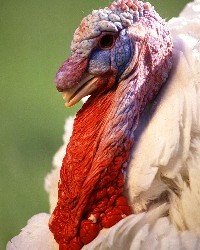10 April 2015. A bioengineering lab at University of Guelph in Ontario, Canada developed a quick, simple test for avian flu virus that infects poultry, including the type of virus now infecting turkeys in the U.S. and Canada. Guelph’s Bionano Lab led by engineering professor Suresh Neethirajan says a description of its device will appear in an upcoming issue of the journal Sensors.
Current testing techniques for avian flu viruses require taking blood samples from birds and sending them to remote labs for analysis. Just the analysis step takes 8 hours, says Neethirajan, and the entire process requires at least 2 days from sample to results.
When testing for avian flu outbreaks, particularly early on, getting results quickly is vital. “It’s critical to get out front of any outbreaks,” notes Neethirajanin in a university statement. “There are many strains, and we need to know the source of the flu. The identification of the strain determines what treatment options we should use.”
The Guelph test, returns results on the spot in about 2 to 3 minutes. The device designed by Neethirajanin and Longyan Chen, a postdoctoral researcher in the Bionano Lab, uses less blood from the birds than current techniques. In addition, the device tests the samples for characteristic surface proteins with a process using gold nanoparticles and quantum dots tuned to emit different colors. Quantum dots are pieces of semiconductor material that make it possible to measure and manipulate single electronic charges.
Not only can the Guelph test indicate the presence of avian flu virus, it can tell the strain of virus for determining the course of treatment. The researchers say their test can discriminate between H5N1 and H1N1 avian flu strains, and can be extended to indicate H5N2 strain causing the current outbreak. Of the 16 hemagglutinin subtypes of influenza — the “H” in virus codes — H5 is associated more with outbreaks in wild and domestic birds, while H1 can also affect humans.
The new avian flu test comes at a critical time for poultry producers in North America. The New York Times reports today that the deadly H5N2 virus, believed to originate in migrating wild birds, is causing turkey farmers Minnesota to euthanize some 525,000 birds, with quarantines occurring in the U.S. West and Midwest. That same virus hit British Columbia in December 2014 and January 2015, and this week was confirmed on a farm in southwestern Ontario by Guelph’s Animal Health Lab, which collaborated on the avian flu test.
Read more:
- Sharp Rise in Livestock Antimicrobial Use Expected
- University Breeds Genome-Edited Pigs
- Alliance to Build Photonic Mosquito Control Device
- Natural Product Can Boost Animal Immune Health
- Genetically Engineered Medflies Found to Control Wild Types
* * *


 RSS - Posts
RSS - Posts
You must be logged in to post a comment.